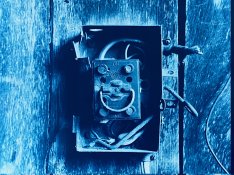Here's the relavant portion in Mike Ware's Cyanomicon:
>>>>>
light + Prussian blue + ferrous ions ---> Prussian white + ferric ions
This tonal reversal is the phenomenon of ‘solarisation’ first observed
and named by Herschel. It is actually desirable for making a print-out
image, because it can ultimately yield a higher maximum density: the
self-masking action by the Prussian blue in the shadow regions of a
printed-out image is diminished by the reversal to white, which allows
the ingress of more light and formation of more (white) product. After the
exposure, the Prussian white so formed is oxidised back to Prussian blue,
either slowly by the oxygen of the air, or more rapidly by including a bath
of an oxidising agent, such as hydrogen peroxide or a dichromate, in the
wet-processing sequence:
Prussian white + hydrogen peroxide ---> Prussian blue + hydroxide ions
<<<<<
Just to clarify my post earlier. In my experiments, the peroxide treated and untreated were measured after the same amount of time (24 hours.) So if peroxide did not complete the oxidation, air would have done so after wet processing. Final density was lower in the peroxide case then probably means that there was some bleaching of the Prussian blue going on as well which was irreversible. That is why in my opinion strictly if you can wait for air oxidation, it would be advisable to do so if maximizing the Dmax was the ultimate goal. If "instant gratification" (as Christopher James says) is sought, on the other hand, go for peroxide or dichromate before final wash and dry.




